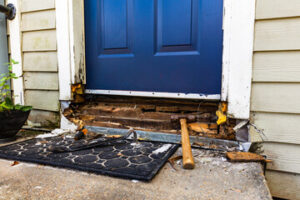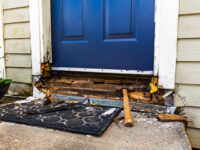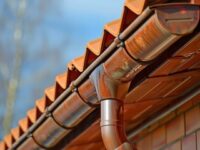Foundation Repair Methods
Foundation Repair Greensboro NC includes a number of techniques aimed at stabilizing your home. Choosing the right method requires accurately assessing the extent of damage.

Doors and windows that no longer latch or close may indicate shifting of your foundation. Sloping floors are another red flag.
Concrete piers or pilings are installed under your house to lift it back to its original position. These supports are inserted underground, either by drilling and then pouring concrete for piers or by using hydraulic pressure for slabjacking.
As the name suggests, underpinning is a foundation repair method that involves digging under existing footings and installing additional support to lift and stabilize them. It’s a more involved repair than filling in cracks or adding drainage, and it’s typically reserved for homes that have been subject to significant structural damage, such as shifting and sinking of the foundation itself. Depending on the cause of the foundation movement, underpinning may be the only way to stabilize and restore your home to its original level.
Underpinning can be done in a number of ways, but generally the process involves excavating a hole under the affected area and then placing a series of steel or concrete piers underneath to serve as “props.” The piers are connected to the existing foundation footings by a system of beams that’s then filled with concrete. This can be a complicated process that’s often reserved for professional builders. However, in some cases it can also be completed by using steel shims to temporarily fill gaps that are caused when soil shifts under the foundation.
Once the piers are installed, the contractor will then raise sunken sections of the foundation to the original height. The process can take days or weeks, and it may require the removal of landscaping, patios, or driveways in order to gain access to the damaged areas. This can cause disruptions in outdoor living spaces, and vibrations may be felt throughout the home.
While some DIY homeowners can manage simple repairs, it’s important to consult with a contractor for complex problems. The right professional will be able to quickly identify the root cause of your foundation problem and recommend the best course of action for lasting repair. They’ll have the necessary tools and expertise to make lasting repairs, which will protect your investment in your home and help it continue to function as it should. They can also provide warranties that offer peace of mind. This is a smart move for any homeowner, especially since certain issues require professional expertise to repair.
Concrete Piers
The pier is a vertical structural support that transfers the weight of your home to stable soil or bedrock. It is installed underneath your concrete foundation, unlike footings that spread the load horizontally.
Concrete piers can be used in many situations when soil conditions aren’t conducive to a slab foundation, like in clay or sandy soil. They are also used to correct foundation problems in older homes that were built on soil that was unstable at the time of construction.
When the piers are installed, they are driven into the ground beneath your home using hydraulic pressure. This is what makes piers different from helical or screw piers, which are pulled into the earth. The piers are then capped with a concrete cap to protect them from the elements and ensure they last a long time.
Since concrete piers are so popular, it can be difficult to tell if you have one in your home. Some common signs of a concrete pier foundation include visible cracks in walls, floors or doors that are misaligned, and uneven or sloping floors.
If you think you may have a pier foundation, it is important to hire a reputable professional for a thorough inspection. They will be able to diagnose the root cause of your issue and recommend the best solution. They should also be able to provide you with a free, no-obligation estimate.
When determining what kind of foundation is the right choice for your house, contractors will consider the type of soil in your area and how deep you need to go for a strong, lasting support system. They will likely also look at your home’s drainage to make sure that the soil under and around your home is able to move moisture away from your foundation.
In addition to the concrete pier itself, it is also possible for your contractor to install other repair methods in conjunction with a pier installation, such as a French drain or crawl space waterproofing. These can help prevent the pier from becoming waterlogged and help your foundation hold up better in the future. They will also discuss options for directing water away from your foundation, such as grading the land around your home to redirect rainwater and runoff.
Steel Piers
When a homeowner’s foundation starts to shift due to weak soil conditions, the best way to stabilize and repair it is with steel piers. Also known as micro piles, push piers, resistance piers, or helical piers, these steel support systems are driven into the earth under your home to transfer the weight of the structure from unstable soil to the stronger, load-bearing ground deeper underneath.
Unlike concrete piers, these steel pilings can be installed in any weather and do not have a time limit on their life span. Steel piers are a permanent solution to foundation problems and can be used for both residential and commercial structures. These piers are able to penetrate deeper into the earth than concrete and other foundation piers, providing outstanding stability that can resist soil movement.
The best thing about steel piers is that they are relatively easy to install and can be done by any qualified foundation repair contractor. However, they require more labor and specialized equipment than concrete piers, so they can cost a little more upfront. However, the extra investment is worth it for homeowners who want a durable and long-lasting solution to their foundation issue.
Another reason why many homeowners choose steel piers over concrete piers is that they do not have the same vulnerability to moisture swelling as concrete piers. Texas soil has a tendency to soak up water, causing it to swell up and shift underneath foundations. This is a huge problem for many types of foundation repair methods. Steel piers, on the other hand, are driven all the way down to bedrock, which is considered non-active soil and will not shift or sink as the weather changes.
When choosing a foundation repair contractor, it is important to look for one with experience installing steel piers. The process requires both strength and precision, so it is important that your foundation specialist knows how to install them properly and accurately. Additionally, they should be familiar with the local soil conditions and regulations. This knowledge is crucial to ensure that your foundation repairs are completed correctly and that your structure will be able to withstand the changing conditions.
Masonry Patching
Masonry patching, or brick repair, is the process of repairing areas of damaged brickwork on a foundation. This can include filling in cracks and replacing damaged bricks or mortar. The repair process is usually done by a masonry restoration contractor and may require other work on the structure to complete the job.
Before the masonry repair can begin, the area must be thoroughly cleaned to ensure that the new material will bond properly with the existing surface. This will involve a thorough scrubbing with a wire brush and washing with vinegar, followed by a rinse with clean water. This will remove any dirt or debris that may have become lodged in the surface of the bricks and help to prevent future damage.
During the masonry repair process, it is important that all construction materials used are of the highest quality. This will help to ensure that the repaired area is both structurally sound and aesthetically pleasing. In addition, all masonry repairs should be made by qualified contractors to ensure that the work is carried out properly and that all local building and safety codes are observed.
To successfully repair brick cracks, it is necessary to prepare the surface of the wall before applying a patching compound. This will require some labor, but it will provide a long term solution to the crack problem. To prepare the wall, all loose material should be removed using a hammer and cold chisel, then the area must be washed down with a garden hose to remove any remaining dust or debris. It is important that the cracks are not filled too tightly, since this can cause further damage to the foundation.
For cracks that are wider than a hairline, foam backer rods can be used to support the patch and prevent the crack from becoming deeper as the caulk dries. These rods are available in a variety of lengths and diameters and can be inserted into the crack with a putty knife. If the crack is very deep, a concrete caulk can be applied after the foam backer rods have been inserted.






